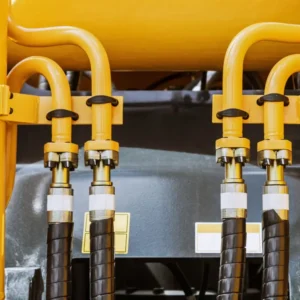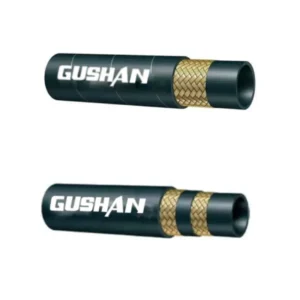Hydraulic hoses are essential components in many industrial and mechanical systems. Over time, these hoses can wear out or become damaged, necessitating replacement. While replacing a hydraulic hose may seem daunting, with the right tools and knowledge, it can be a relatively straightforward task.
This guide will walk you through the steps involved in replacing a hydraulic hose, providing clear instructions and safety tips.
How to Replace a Hydraulic Hose
Disclaimer: While this guide provides a general overview, replacing a hydraulic hose can be a complex task, often requiring specialized tools and knowledge. It’s always recommended to consult with a qualified technician or mechanic, especially if you’re unfamiliar with hydraulic systems.
Safety First:
- Wear protective gear: Always wear safety glasses, gloves, and protective clothing to protect yourself from potential injuries.
- Release system pressure: Ensure the hydraulic system is completely depressurized before starting the replacement process. This can usually be done by releasing pressure valves or using a pressure relief valve.
Tools and Materials Needed:
- Hydraulic hose cutter
- Hose crimping tool
- New hydraulic hose
- New fittings
- Wrenches
- Hydraulic fluid
- Leak detection solution
Step-by-Step Guide about Hydraulic Hose Replacement
Step 1: Isolate and Drain the System:
- System Isolation: If feasible, isolate the section of the hydraulic system where the hose is located to minimize fluid loss. This can be accomplished by closing valves or disconnecting hoses.
- Fluid Drainage: Employ a drain pan or container to collect the hydraulic fluid. Exercise caution, as hydraulic fluid can be harmful to the environment. Dispose of it responsibly according to local regulations.
Step 2: Disconnect the Old Hose:
- Locate the Hose: Identify the specific hose that requires replacement.
- Release Fittings: Utilize wrenches to carefully loosen and remove the fittings from both ends of the old hose.
- Clean the Fittings: Thoroughly clean the fittings and mating surfaces to ensure a clean connection for the new hose. Employ a wire brush or rag to remove any dirt, debris, or old sealant.
Step 3: Measure and Cut the New Hose:
- Accurate Measurement: Precisely measure the length of the old hose, taking into account any bends or curves.
- Precise Cutting: Use a hydraulic hose cutter to cut the new hose to the exact length, ensuring a clean and accurate cut.
Step 4: Prepare the Hose Ends:
- Skiving or Flaring: Depending on the type of fittings, prepare the hose ends by skiving or flaring them. This involves shaping the end of the hose to create a specific profile for a secure connection.
- Cleaning: Clean the prepared hose ends to eliminate any debris or contaminants.
Step 5: Attach the Fittings:
- Hose Insertion: Insert the prepared hose ends into the fittings.
- Crimping: Utilize a hydraulic hose crimping tool to crimp the fittings onto the hose, ensuring a secure and leak-proof connection. Adhere to the manufacturer‘s instructions for the specific crimping procedure.
- Tightening: Tighten the fittings to the manufacturer‘s specified torque.
Step 6: Install the New Hose:
- Routing: Carefully route the new hose, avoiding sharp bends, excessive twists, and contact with hot surfaces.
- Securing: Employ clamps or other methods to secure the hose in place, preventing movement and potential damage.
- Connecting Fittings: Connect the fittings to the hydraulic system components, ensuring a tight fit.
Step 7: Bleed the System:
- Cycle the System: Operate the hydraulic system to circulate the fluid and expel air bubbles.
- Bleeder Valve: If equipped, use a bleeder valve to release air from specific points in the system.
- Air Pocket Monitoring: Monitor the system for any signs of air pockets, such as noisy operation or sluggish performance.
Step 8: Test for Leaks:
- Visual Inspection: Visually inspect all connections for leaks.
- Leak Detection Fluid: Apply a leak detection solution to the fittings and connections to identify any leaks.
- Pressure Test: If feasible, pressure test the system to ensure there are no leaks.
Step 9: Final Inspection:
- Connection Verification: Double-check all connections to ensure they are tight and secure.
- System Operation Verification: Test the hydraulic system to confirm its correct operation.
Remember, if you’re unsure about any step or encounter difficulties, seek professional help.
By following these steps and taking necessary precautions, you can successfully replace a hydraulic hose and ensure the continued operation of your hydraulic system.
When to Replace a Hydraulic Hose
It’s crucial to replace a hydraulic hose at the right time to prevent accidents, equipment damage, and costly downtime. Here are some key indicators that signal the need for replacement:
Visual Signs of Wear and Tear:
- Cracks or Cuts: Visible cracks or cuts in the hose’s outer cover or inner tube are clear signs of damage.
- Abrasions: Excessive wear and tear from rubbing against other components can weaken the hose.
- Kinks: Kinks in the hose can restrict fluid flow and damage the internal structure.
- Exposed Reinforcement: If the reinforcement wires are exposed, the hose has been compromised.
Performance Issues:
- Fluid Leaks: Any visible leaks or wet spots around the hose or fittings indicate a problem.
- Reduced Pressure or Flow: A decrease in hydraulic pressure or flow rate can be a sign of a failing hose.
- Noise or Vibration: Unusual noises or vibrations from the hydraulic system may indicate a worn or damaged hose.
Age and Operating Conditions:
- Age: Over time, hydraulic hoses can degrade due to exposure to heat, cold, UV radiation, and other environmental factors.
- Operating Conditions: Harsh operating conditions, such as high pressure, high temperature, or exposure to chemicals, can accelerate hose degradation.
Preventive Maintenance:
- Regular Inspections: Conduct regular visual inspections of hoses for signs of wear and tear.
- Proper Installation: Ensure hoses are installed correctly, avoiding kinks and excessive stress.
- Avoid Extreme Conditions: Protect hoses from extreme temperatures, excessive vibration, and exposure to harmful chemicals.
- Replace Worn Hoses Promptly: Replace any damaged or worn hoses immediately to prevent accidents and downtime.
By following these guidelines and conducting regular inspections, you can identify potential issues early on and take steps to replace worn or damaged hoses before they fail. This will help to ensure the safety and reliability of your hydraulic system.
How Much Does It Cost to Replace Hydraulic Hoses
The cost to replace a hydraulic hose can vary significantly depending on several factors:
- Hose Length and Diameter: Longer and larger diameter hoses typically cost more.
- Hose Material and Type: The specific material and type of hose (e.g., rubber, wire braid, or thermoplastic) will influence the price.
- Fittings and Adapters: The type and complexity of the fittings and adapters required can impact the cost.
- Labor Costs: If you hire a professional to replace the hose, labor costs can vary depending on the complexity of the job and regional rates.
Generally, the cost of replacing a hydraulic hose can range from $20 to $200 or more.
Factors Affecting Cost:
- DIY vs. Professional Installation: If you attempt to replace the hose yourself, the cost will primarily be the price of the hose and fittings. However, professional installation can add labor costs.
- Hydraulic Fluid: If the replacement requires a fluid flush or refill, the cost of the fluid will be an additional expense.
- Emergency Repairs: Emergency repairs, especially during off-hours or in remote locations, may incur additional fees.
To get a more accurate estimate, it’s best to consult with a hydraulic hose specialist or a local mechanic. They can assess your specific needs and provide a detailed quote.
Tips for Cost-Effective Replacement:
- Buy Quality Hoses: Investing in high-quality hoses can extend their lifespan and reduce the need for frequent replacements.
- Regular Maintenance: Regular inspections and maintenance can help prevent premature hose failure.
- DIY Replacement: If you have the skills and tools, replacing the hose yourself can save on labor costs.
- Shop Around: Compare prices from different suppliers to get the best deal.
By considering these factors and taking proactive steps to maintain your hydraulic system, you can minimize the cost of hydraulic hose replacements.
How Often to Replace Hydraulic Hoses
The lifespan of a hydraulic hose can vary depending on several factors, including operating conditions, maintenance, and the quality of the hose itself. However, a general guideline is to replace hydraulic hoses every 2-5 years.
Key Factors Influencing Lifespan:
- Operating Conditions:
- Temperature: Extreme temperatures, both high and low, can accelerate hose degradation.
- Pressure: High-pressure applications can stress the hose material.
- Vibration: Constant vibration can cause fatigue and wear.
- Chemical Exposure: Exposure to chemicals can deteriorate the hose material.
- Maintenance:
- Regular Inspection: Frequent visual inspections can help identify signs of wear, such as cracks, cuts, or leaks.
- Proper Installation: Correct installation can prevent premature failure due to kinking or excessive stress.
- Avoidance of Extreme Conditions: Protecting hoses from extreme temperatures, excessive vibration, and harmful chemicals can prolong their life.
Signs of Wear and Tear:
- Visible Damage: Cracks, cuts, or abrasions on the hose surface.
- Fluid Leaks: Any leakage of hydraulic fluid indicates a problem.
- Kinks or Bends: These can restrict fluid flow and damage the hose.
- Discoloration or Stiffening: Changes in the hose’s appearance or flexibility.
Remember, replacing a hydraulic hose before it fails completely can prevent costly repairs and downtime. Regular inspections and preventive maintenance are crucial to ensure the safety and reliability of your hydraulic system.
If you have any concerns about the condition of your hydraulic hoses, consult with a qualified technician for a thorough inspection and advice.
Conclusion
Replacing a hydraulic hose can be a complex task, but by following these steps and taking necessary precautions, you can successfully complete the job. Remember, safety is paramount, so always wear protective gear and follow proper procedures.
If you’re unsure about any step or encounter difficulties, it’s best to consult with a qualified technician or mechanic.
Need high-quality hydraulic hoses for your next project?
Gushan Rubber offers a wide range of durable and reliable hydraulic hoses to meet your specific needs. Our hoses are designed to withstand demanding conditions and provide optimal performance.
Contact us today to learn more about our products and services.



